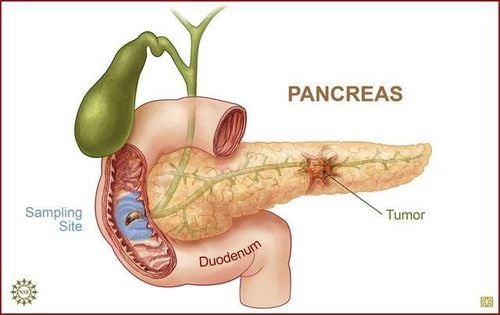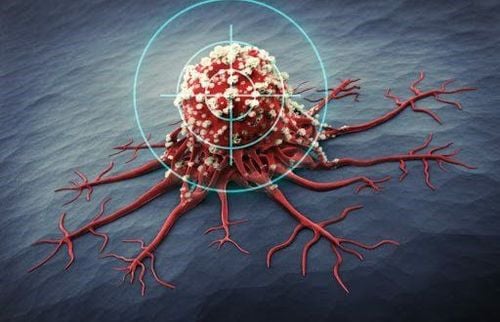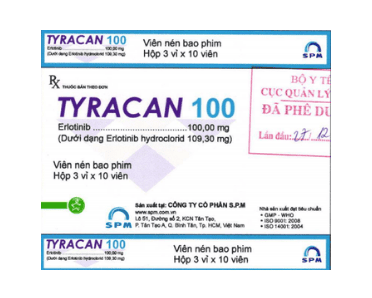This is an automatically translated article.
Article by Master, Doctor Mai Vien Phuong - Gastrointestinal endoscopist - Department of Medical Examination & Internal Medicine - Vinmec Central Park International General Hospital.
Pancreatic neuroendocrine tumors can lead to a variety of symptoms, depending on the type of hormone it produces. If the tumor becomes malignant and spreads to other parts of the body, the cancer can become very serious.
1. What is the pancreas?
The pancreas is a leaf-shaped organ that produces digestive enzymes as well as hormones (eg insulin). The pancreas is located high in the abdomen, near the major veins and arteries. The pancreas has three parts:
Head of the pancreas The tail of the pancreas The body of the pancreas. Digestive enzymes and hormones produced by the pancreas travel from the pancreas to the duodenum through the pancreatic duct. The part of the pancreas that produces hormones is called the endocrine pancreas, and the part that produces digestive enzymes is called the exocrine pancreas.
2. What is a pancreatic neuroendocrine tumor?
Pancreatic cancer occurs in the tissues of the pancreas, which is an important endocrine organ located behind the stomach. The pancreas has an essential role in digestion, producing enzymes that the body needs to digest fats, carbohydrates, and proteins.
A pancreatic neuroendocrine tumor (PNET) develops in the pancreas from a type of cell called a neuroendocrine or endocytic cell. These cells produce and release hormones such as insulin and glucagon into the bloodstream.
Pancreatic neuroendocrine tumors can be benign (non-cancerous) or malignant (cancerous). Some pancreatic tumors can cause overproduction of these hormones.
Only 7% of pancreatic cancer cases cause pancreatic neuroendocrine tumors, so these tumors are rare. However, pancreatic neuroendocrine tumors can lead to a variety of symptoms, depending on the type of hormone it produces. If the tumor becomes malignant and spreads to other parts of the body, the cancer can become very serious.
Other names for pancreatic neuroendocrine tumors are:
Pancreatic endocrine neoplasms Pancreatic islet cell tumors Langerhans islet cell tumors

3. Types of Pancreatic Neuroendocrine Tumors Pancreatic neuroendocrine tumors can be non-functional or functional. Specifically:
3.1. Nonfunctional pancreatic neuroendocrine tumors Nonfunctional pancreatic neuroendocrine tumors produce substances and cause no symptoms. The only symptoms are the result of the growth and spread of the tumor.
These tumors are usually malignant.
3.2. Functional Pancreatic Neuroendocrine Tumors Functional tumors are those that produce a hormone that causes symptoms. The 3 main types of functional tumors are insulin, gastrinomas, and glucagonomas. Other functional tumors exist, but they are extremely rare.
Insulinoma: An insulinoma is a tumor that produces the hormone insulin. Insulin is responsible for controlling blood sugar levels. Insulinomas are the most common functional pancreatic neuroendocrine tumor, accounting for nearly 70% of cases. They are usually benign. Gastroenteritis: Gastroenteritis occurs when a tumor develops from the neuroendocrine cells that make the hormone gastrin. Gastrin helps release stomach acid to digest food. Tumors are usually malignant. Glucagonoma: A tumor that produces the hormone glucagon is called a glucagonoma. This hormone causes the liver to release glucose or sugar into the bloodstream. Glucagonomas are usually malignant. Rare functional tumors: There are several types of extremely rare functional pancreatic neuroendocrine tumors. These include VIPomas, which produce enteric-active peptides (VIPs). Somatostatinomas are another. They produce the hormone somatostatin and control the amount of sugar, water and salt in the human body. 4. What are the stages of a pancreatic neuroendocrine tumor? As with other cancers, stages are used to describe how advanced a pancreatic neuroendocrine tumor is.
According to the American Joint Committee on Cancer (AJCC), the TNM system uses a scale of 1 to 4 for pancreatic neuroendocrine tumors. It takes into account the following:
The size of the tumor (T) Whether the tumor has spread to nearby lymph nodes (N) Whether the tumor has metastasized or spread to distant sites (M ) 4.1. Stage 1 Pancreatic neuroendocrine tumor In stage 1, the pancreatic neuroendocrine tumor is no larger than 2 centimeters (79 inches) across and remains confined to the pancreas.
4.2. Stage 2 Pancreatic neuroendocrine tumor In some forms of stage 2, the tumor is larger than 2 centimeters (79 inches) across but is still confined to the pancreas.
You can also be diagnosed with stage 2 if the tumor has not spread to nearby lymph nodes or distant sites, but it has reached the common bile duct or duodenum.
4.3. Stage 3 Pancreatic Neuroendocrine Tumor You will be diagnosed with a stage 3 pancreatic neuroendocrine tumor if:
The tumor has spread to nearby blood vessels or organs (such as the large intestine or spleen) ), but it has not spread to nearby lymph nodes or distant sites. The tumor has spread to nearby lymph nodes but not to distant sites. Tumors can be any size, and may or may not be limited to the pancreas. 4.4. Stage 4 Pancreatic neuroendocrine tumor You will be diagnosed with stage 4 pancreatic neuroendocrine tumor if the tumor has spread to distant sites in the body.
You will receive this diagnosis regardless of the size of the tumor, whether it is confined to the pancreas, or whether it has spread to nearby lymph nodes.

5. What are the symptoms of a pancreatic neuroendocrine tumor? Symptoms of PNET vary depending on the type of tumor.
Symptoms of a non-functional tumor arise from the growth and spread of the tumor. Symptoms of functional tumors depend on hormones being produced and released into the bloodstream.
5.1. Symptoms of a Nonfunctional Tumor Symptoms of a Nonfunctional Pancreatic Neuroendocrine Tumor include:
Indigestion Abdominal Distention Diarrhea Abdominal pain Abdominal Tumor Yellowing of the skin and sclera of the eyes 5.2. Symptoms of a gastric pathology Symptoms of an epithelial tumor include:
Recurrent gastric ulcer Abdominal pain that responds to antacids Gastroesophageal reflux disease Diarrhea 5.3. Symptoms of an insulinoma Insulinoma can cause a high heart rate and low blood sugar. Symptoms if blood sugar is low are:
Headache Blurred vision Weakness Irritability Increased hunger 5.4. Symptoms of a glucagonoma Symptoms of a glucagonoma include:
Rash on the abdomen, legs, or face Diarrhea Unexplained weight loss Tons and mouth sores A glucagonoma can also cause blood clots, possibly can lead to the following symptoms:
Shortness of breath Chest tightness Cough Pain in arms or legs Swollen hands or feet A glucagonoma can also cause high blood sugar, which can lead to the following symptoms:
Headache Dry skin Frequent urination Hunger Thirst 6. How is pancreatic neuroendocrine tumor diagnosed? The first step in diagnosing a pancreatic neuroendocrine tumor is to complete a complete physical exam, taking into account your and your family's medical history. The next step in diagnosing a pancreatic neuroendocrine tumor is a blood test or imaging technique to look for a tumor.
Blood tests to find elevated levels of hormones and blood glucose levels. Increased levels may indicate pancreatic neuroendocrine tumor. Imaging tests allow your doctor to visualize your pancreas and look for the presence of a tumor. These tests may include an ultrasound, an MRI scan, or a CT scan. Another way to get a picture of the pancreas is to perform minor exploratory surgery. Your doctor may want to insert a small camera or endoscope into your abdomen to see your pancreas. They may also choose to take a small tissue sample for a biopsy. 7. Treatment options for pancreatic neuroendocrine tumors When a benign pancreatic neuroendocrine tumor is diagnosed, treatment may involve medication alone. If symptoms are severe, surgical removal of the tumor may be indicated.
Surgery is the most common treatment for malignancies. The goal of surgery is to remove as much of the tumor as possible. If the tumor is present in other areas of the body, such as the liver or lungs, the surgeon may also remove it from those locations. If the cancer has spread throughout the body, you may need chemotherapy to reduce the size of the tumor.
In summary, the survival rate of people with pancreatic neuroendocrine tumor is higher than that of people with pancreatic cancer. If your doctor finds a malignant tumor before it has spread beyond the pancreas, the outlook is good. Surgery to remove it usually cures the cancer. The more cancer cells spread throughout the body, the lower the chance of recovery.
If the tumor is benign, the outlook is also good. Doctors can often remove benign tumors and cure the disease through surgery. Medicines can relieve symptoms caused by excess hormones.
The above information is for reference only. You should consult your doctor before deciding on any treatment.
Pancreatic ultrasound is a way to help detect and diagnose some pancreatic diseases quickly and effectively. If you suspect that you have pancreatic disease, you can come to Vinmec International General Hospital System, one of the leading prestigious hospitals in the country, Vinmec uses current generations of color ultrasound machines. the most modern in examination and treatment for patients. One of them is GE Healthcarecar's Logig E9 ultrasound machine with full options, HD resolution probes for clear images, accurate assessment of lesions. In addition, a team of experienced doctors and nurses will greatly assist in diagnosing and early detection of abnormal signs of the body in order to provide timely treatment for pancreatic diseases.
Please dial HOTLINE for more information or register for an appointment HERE. Download MyVinmec app to make appointments faster and to manage your bookings easily.
References:Islet cell tumors of the pancreas/Endocrine neoplasms of the pancreas. (n.d.) pathology.jhu.edu/pancreas/TreatmentEndocrine.php Neuroendocrine tumor of the pancreas: Stages and grades. (2019). cancer.net/cancer-types/neuroendocrine-tumor-pancreas/stages-and-grades Pancreatic neuroendocrine tumors. (2020). cancer.gov/types/pancreatic/patient/pnet-treatment-pdq Pancreatic neuroendocrine tumors (PNETs). (n.d.). pancan.org/facing-pancreatic-cancer/about-pancreatic-cancer/types-of-pancreatic-cancer/endocrine-pancreatic-neuroendocrine-tumors














